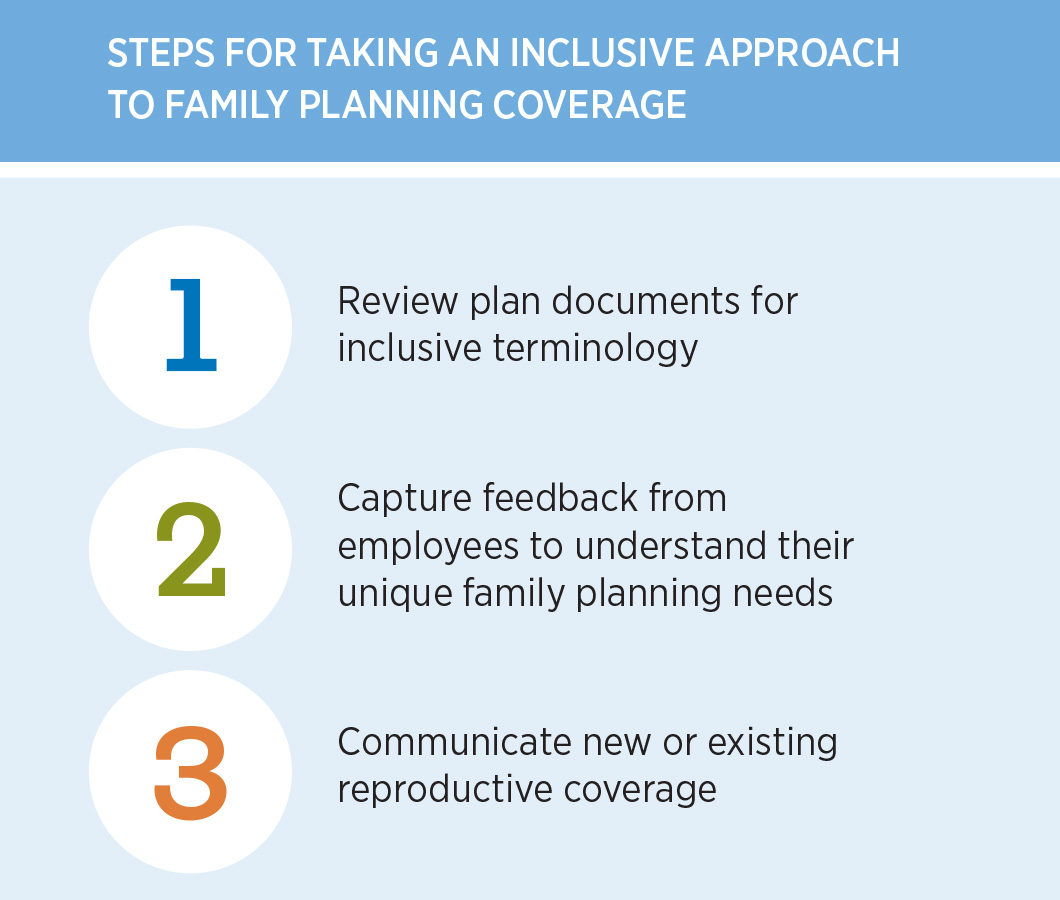Authors: Tammy Olson Kathi Wright

The Supreme Court ruling in Dobbs v. Jackson Women's Health Organization has implications for benefit decisions on a scale that extends well beyond the legality of abortion. This sweeping historical change is requiring employers to revisit the diverse reproductive and family planning needs of their workforce. To compete in a tight labor market, it's no longer enough to limit family planning considerations to binary definitions or relegate them to the women's health arena.
Until the controversy over recent legislation is settled in state courts or, less likely, certain protections are codified at the federal level, employers will find themselves in a difficult position. And heavy reliance on legal counsel is necessary if they want to change abortion-related coverage.
Strategies for ensuring inclusive family planning coverage
Despite current legal entanglements in the courts, employers can cost-effectively invest in inclusive family planning coverage. The simple process starts with replacing outdated descriptions with inclusive terminology — gender-neutral designations — based on a review of existing plan documents.
An understanding of diverse workforce perspectives comes next. Following the Dobbs ruling, 52% of employers have acted to support family planning and reproductive care. Yet there's an opportunity to further understand the experience of employees. Just 9% of employers gather feedback on the importance of reproductive and family planning benefits, and only 5% capture financial concerns about family planning and childcare.1
The last step is creating awareness among the workforce by communicating the availability of coverage and highlighting any changes. While abortion access made media headlines over the summer, the most immediate concerns for many employees focus on the availability of family formation benefits through employer-sponsored coverage.
Solutions that address misconceptions about inclusive coverage
Prior to the Dobbs decision, employers may have presumed that documents for their family formation benefits were thorough, but verification is important. Content could contain bias terminology that risks alienating talent, whether it's their own content or content provided by a vendor.
Revisiting the gender and sexuality phrasing or identification used in family planning benefits and making updates as needed is a key step toward benefits equity. Minimal effort is required for this action, which helps ensure that policies are culturally conscious and align with the organization's overall people strategy. So far, 7% of employers have reviewed their definition of family formation for inclusion of same-sex, non-binary and gender non-conforming partnerships.1
To stay competitive, some benefit policies will need revisions to include all paths to parenthood. Family formation statements that only mention male-female unions when describing family units are obsolete. According to one recent survey, 63% of lesbian, gay, bisexual, transgender, and queer or questioning (LGBTQ) millennials are thinking about starting a family or expanding the one they have.2

The needs of LGBTQ employees will likely include access to assisted reproductive technologies such as in vitro fertilization (IVF), intrauterine insemination, surrogacy and/or cryopreservation. Some healthcare plans stipulate a waiting period when trying to conceive before fertility benefits kick in, which should be waived to avoid discriminating against same-sex couples.3
Parental leave policies may include archaic phrasing that only applies to biological mothers and fathers. Inadvertently, this wording misses the needs of individuals and couples who are taking non-conventional routes to building a family. Thirteen percent (13%) of employers are currently reviewing the inclusion of adoption, surrogacy and/or foster care in their parental leave polices.1
Data-based insights into preferred benefits for a diverse workforce
Alignment of diversity, equity and inclusion (DEI) strategies with the reproductive challenges faced by employees demonstrates clear support for equitable benefits. Especially when seeking to attract and retain the most qualified people in a tight labor market, identifying preferred family formation benefits is a top priority.
But currently just 6% of organizations evaluate how race, gender, sexuality and/or ethnicity characteristics affect access to high-quality reproductive care.1 Apart from employer-sponsored coverage, necessary reproductive care may not be available to employees in their community or state.
Through a workforce survey or focus group, employers can get a better read on employee needs while demonstrating the organization's commitment to fostering an inclusive culture. Vocal employees are an asset for calling attention to inequities in serving marginalized groups, even in small numbers.
The importance of benefits education and recommunication
Awareness building can often settle concerns during a period of uncertainty. Education on family formation options is especially helpful for employees, who may underutilize benefits that aren't described in broadly relatable terms. As of September 2022, 34% of employers are recommunicating their existing coverage for family planning benefits — an uptick from 6% in the weeks immediately following the Supreme Court's ruling.1, 4
Up-channel education of senior leadership adds the potential for enhanced outcomes. Many in this demographic could benefit from understanding the difficulties employees encounter in a new era of family planning.
At its face value alone, coverage for family planning doesn't reduce or stabilize costs, but nonmaterial gains can be significant. Employees who feel supported as they begin a life-altering journey into parenthood, with all of its responsibilities, will likely be less inclined to leave for another organization.


